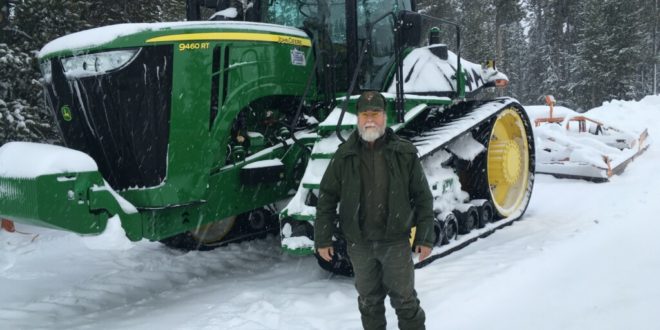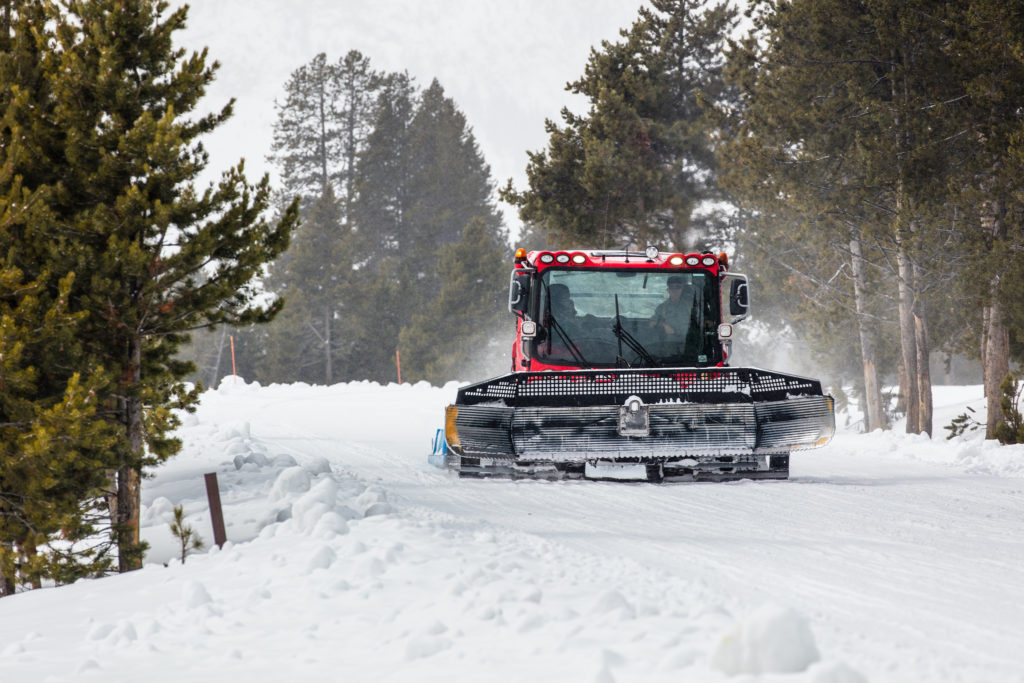You might not associate winter in Yellowstone with snow-grooming equipment like the gear used at downhill ski resorts.
But Yellowstone National Park grooms most of its main oversnow routes seven nights a week during the park’s December to March winter season with just such equipment.
One of the employees who drives grooming equipment is 20-year NPS staffer David Donkersgoed, 62, based out of West Yellowstone, Montana. Most of the year, Dave is a heavy-equipment operator, but for three months in the winter, he’s out four nights a week from about 4 p.m. to midnight smoothing out the snow-covered roads on his 100-mile route.
Dave drives a John Deere tractor that pulls a 28-foot long, 14-foot wide Trailmaster groomer attachment. His route includes West Yellowstone to Madison Junction, then north as far as Norris Junction and south as far as Old Faithful.
He can do the full route in his 10-hour shift, traveling at a speed of 12-13 mph.
He has the choice of deciding whether to groom north or south first. If he goes south first, he can get to Old Faithful around 8:30 p.m. There’s cell reception at Old Faithful, so he can call his wife, Sue, before she goes to bed.
Safety
Being out alone on the park roads at night calls for some safety precautions. His tractor cab has a two-way radio. At the start of each shift he calls in to the park’s Communications, or Comm Center, with his call number. Dispatchers check in with him every hour or so and ask for his location.
Conditions can include everything from a whiteout blizzard to temperatures well below 0. When it’s snowing hard, sometimes it’s hard to see much beyond the front of the tractor. One time it was snowing so hard Dave had to just stop because he couldn’t see at all. And when the Comm Center radioed to ask where he was, he wasn’t exactly sure.
“I think I’m at the top of the Madison hill,” Dave recalled saying.
In addition to his regular work gear, he carries an extra bag with survival gear including a snowmobile suit, hats and gloves in case of a mechanical breakdown and the engine can’t run to keep the cab warm.
“If you can’t have it run, you don’t want to be out very long if it’s very cold,” Dave said.
Dave recalled an evening he was grooming and the engine began to overheat. He thinks a piece of plastic may have come up off the road and punctured the radiator. Luckily, a ranger out on patrol on snowmobile was available to give him a ride to Madison Junction and then a ride back to West Yellowstone.
Breakdowns are rare, but more common during severe cold, like 20 to 30 degrees below zero.
“When it does get really cold, things break, and that’s a bad thing,” Dave said. “If I break down when it’s 25 or 30 below they have to send someone to get me, and that’s bad for them, too.”
Sees cool stuff
While not a natural night owl, Dave likes grooming and being out in the park at night. He’s seen a lot of cool things, lots of animals, of course, like bison and wolves and bobcats.
And he’s seen a lot of shooting stars.
Yellowstone’s night sky, on a crystal clear, frigid winter night, especially under a full moon, is almost beyond description. The Milky Way looks close enough to touch. Under a full moon, the landscape lights up reverse relief like a photo negative, the steam from geysers and hot springs climbing into the air.
Dave recalls seeing a meteor one night. He thinks it might have been that meteor that crashed into Russia a few years ago.
“It looked like the size of a Volkswagen coming down over Fountain Paint Pots,” he said.
Then and now
Back in the days before snowmobilers had to ride with a guide, Dave said he often came upon riders who needed help, and he enjoyed stopping to help. Riders would find themselves stuck, or with a breakdown or maybe they were having trouble with the altitude.
And the roads were a lot rougher then. A couple of thousand snowmobiles a day created a large washboard effect on the road, known as “moguls.” Moguls went up and down like the waves on a body of water. The only stretch that’s rough these days is between Midway Geyser Basin and Old Faithful, Dave said.
Today, everybody, with the exception of some park employees who have to ride a snowmobile to get to work, snowmobiles with a guide, and they all ride four-stroke snowmobiles, which are quieter and less-polluting than the traditional two-stroke machine. Dave said the change is “really good” because riders today don’t speed or ride off the road.
Another change Dave has observed over the years is the weather.
“We don’t get the snow we used to get,” he said. “I moved here in ’78, and you’d never see a fence because there was always six to seven feet of snow. In [West Yellowstone], they dug down to get in the door of businesses. Last year they talked about it being a real heavy winter, that was almost like a light normal winter like it used to be. The weather has really changed.”
 Yellowstone Insider Your Complete Guide to America's First National Park
Yellowstone Insider Your Complete Guide to America's First National Park







You must be logged in to post a comment.